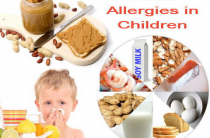Food allergy is a type of allergic reaction, the issue of which is one of the most relevant in modern medicine. Food components can serve as allergens for a person who has the appropriate sensitivity. This means that their penetration through the walls of the gastrointestinal tract into the blood is the reason for which the body carries out an immune response.
Causes of food allergies
An allergy can manifest itself as a result of eating any product. The leading role in the occurrence of this disease belongs to immune reactions, which are highly individual for the body of a particular patient. In general, foods that contain a large amount of proteins in their composition have the greatest potential as allergens. Among these proteins are those that cannot be processed by the gastrointestinal tract. As a result, they enter the bloodstream not as individual amino acids, but as large molecules that provoke the patient's immune system. This circumstance is due to the manifestations of the symptoms of food allergies in violations of the gastrointestinal tract.
Factors that contribute to food allergies:
- Early childhood (improper feeding is of particular danger);
- Lack of breastfeeding in the first 6 months;
- When breastfeeding, the mother did not adhere to a special diet;
- gastrointestinal diseases;
- Stress and eating disorders, as well as an unhealthy lifestyle;
- The presence of an allergic disease among parents or relatives;
- The spread of harmful intestinal microflora, a decrease in the population of beneficial bacteria involved in the processing of the intestine;
- Living in ecologically harmful areas.
Despite the fact that the factors initiating food allergy reactions are known, the question remains why they still provoke the development of allergic food intolerance in only a part of people.
Mechanisms of food allergy development
And so, allergy is an inadequate acute reaction of the body, when interacting with high-molecular safe components. The appearance of an immune reaction, in the case of a food allergy, occurs after the components of the food have been digested. The immune response is a complex chain of biological events during which antibodies are released. Binding and expelling allergens from the body is the main purpose of these proteins. And they do it with the help of allergy symptoms.
Improper functioning of the immune system causes an inadequate assessment of the degree of danger of a substance. Therefore, the ingress of a harmless food component and provoke an immune response. It all comes down to the predisposition that the immunity of the patient himself has. The chains of allergic reactions are activated instantly after the penetration of the allergen into the immune-sensitive human body through the gastrointestinal tract has taken place. During the primary interaction, special recognition mechanisms come into play, which our immunity is endowed with. After that, the production of special antibodies begins, which are able to enter into a biochemical reaction with allergens. And already during the second contact, when the means for the immune response were formed in the body, allergy symptoms develop.
You can find many different manifestations of food allergies, which seem to belong to different diseases. This is due to the fact that various tissues of the body have an immune system, and their sensitivity depends on the individual characteristics that prevail in the patient's body. This is what causes all the variety of clinical manifestations of this disease. Sensitivity to the same products may vary from case to case. Based on these symptoms, the schemes for the treatment of food allergies also differ significantly.
Food allergy symptoms
The symptoms of an allergic reaction to food come in a wide variety of forms. The time interval from eating an allergen to their noticeable manifestation can vary significantly. The reaction can develop immediately - literally within 10-20 minutes, and may occur after a week. In the latter case, it is very difficult to trace the product that causes an unwanted reaction in the body. The most common manifestations of food allergies are disorders of the digestive system, as well as the skin. The respiratory organs and eyes can also be involved in the processes of allergic reactions, which, however, happens much less frequently.
Gastrointestinal manifestations
The gastrointestinal tract, before other organs, takes the blow that allergens inflict on the body. The severity of the symptoms affecting this system may vary. The main manifestations are: nausea (may be from mild dizziness to intense vomiting); pain in the abdomen; stool with blood or fatty fragments. Since the gastrointestinal system is involved in the processes of digestion, and hence the assimilation of food, the disorders caused by allergies affect the patient's well-being. At the same time, the allergic person feels weakness, appetite disorders, and against the background of a long course of allergy, symptoms of a lack of various vital nutritional components (proteins, fats, carbohydrates, vitamins, minerals) may develop.
Skin symptoms
In addition to lesions of the gastrointestinal tract, skin manifestations occupy a significant place in the symptoms of food-induced allergies. There are inflammatory phenomena that develop along with a rash of varying severity. Skin symptoms in food allergies are accompanied by severe itching in the affected areas. In this case, combing only exacerbates skin manifestations, leading to additional injuries.
Respiratory system and organs of vision
Symptoms of a food allergy can also include respiratory and eye damage. In this case, redness of the eyes, increased tearing, sneezing, runny nose and nasal congestion are observed.
Quincke's edema
Quincke's edema is edematous manifestations of the deep layers of the skin and mucous membranes. It can occur on the face, arms, legs, as well as the larynx (in the latter case, it is life-threatening).
Anaphylactic shock is a spasm of the bronchi and muscles of the larynx. As in the case of Quincke's edema, it can be fatal.
Food Allergy Diagnosis
Many factors and data are taken into account when making a diagnosis of food allergy. Among them, the most important are: the patient's testimony, medical examination and test results. During the survey, the doctor must find out the degree of dependence of the symptoms on certain foods that the patient has eaten. Symptoms are also carefully checked during the examination. Swelling of the larynx can also be part of the symptoms of a food allergy. To this end, it is necessary to conduct a thorough examination of the oral cavity.
During a blood test, the concentration of eosinophils is detected, significantly exceeding the average characteristics. These cell structures are involved in the production of antibodies, so food allergies often resolve with an increase in the total number of these structures. Special laboratory tests reveal an increase in the level of antibodies in response to a specific stimulus. Thanks to this, it is possible to assess the allergenic potential of the components of a particular product. Due to the fact that the symptoms of allergies and helminthic invasion are indistinguishable, it is necessary to conduct tests for the presence of helminths. A negative result serves as proof of the nutritional nature of the disease.
In addition to laboratory methods for conducting diagnostic measures, special diagnostic observations are also used. To do this, the patient notes in special records the product, the amount and time at which it was consumed. Based on this, there is a narrowing of the circle of hypothetical culprits of food allergies. Then comes the exclusion of these products for two weeks. During this time period, the symptoms of food allergy without allergenic influence have time to disappear.
Further, products that are hypothetical allergens are gradually being introduced. The doctor selects the optimal interval, which allows you to distinguish which product is allergenic. This diagnostic method shows effectiveness in case food allergy proceeds as a chronic disease. During such a diagnosis, there is a risk of insufficient intake of nutrients if a large list of products is excluded. Therefore, the doctor without fail adjusts the patient's diet in order to replenish these substances.
Food Allergy Treatment
They begin direct treatment only after the fact of a food allergy has been confirmed during a complete examination. The exclusion of highly allergenic foods for life should be carried out taking into account their nutritional value. It is necessary to select products that have equivalent beneficial characteristics, but do not cause allergies.
Medical treatment
Histamine H1 receptor blockers (claritin, tsetrin, astemizole, azelastine, erius, tavegil, diazolin, demidrol, etc.). This group of drugs allows you to eliminate the effect of histamine (the hormone responsible for allergy symptoms) on cells that have sensitive receptors. Under the influence of antihistamines, stabilization of the patient's condition is achieved, skin and respiratory symptoms of food allergies are reduced, and eye lesions are eliminated. The drugs differ somewhat depending on the symptomatic effect, as well as side effects and individual tolerability. This determines the appointment of a particular drug in a particular case.
Corticosteroid drugs. Medicines of this group lead to the most rapid elimination of various forms of allergic reactions. Due to the fact that the side effects of these drugs are very serious, they are prescribed in the minimum required course.
Sorbents. The use of specialized sorbent preparations allows you to bind the allergens in the gastrointestinal tract and remove them. This allows you to significantly minimize their penetration into the body.
Elimination of acute manifestations of allergies
The first treatment for angioedema or anaphylactic shock is the use of injectable adrenaline. It has such important effects as the removal of edema by normalizing blood flow and improving breathing. Then antihistamines and corticosteroids are administered. Their use is carried out in dosages many times higher than regular values. During the treatment of Quincke's edema, diuretics are used, which remove excess fluid formed in the tissue during edematous phenomena.















